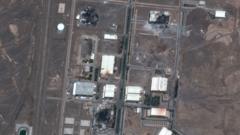Following a tragic attack that killed 26 tourists in Pahalgam, India faces increasing pressure to respond militarily. Experts predict a calibrated response aimed at deterring further violence while navigating the risks of escalation with Pakistan.
India's Potential Response to the Kashmir Attack: A Region on Edge

India's Potential Response to the Kashmir Attack: A Region on Edge
The deadly assault on tourists in Kashmir raises questions about India's response and the implications for regional stability.
The recent brutal attack in Pahalgam, Kashmir, which resulted in the deaths of at least 26 tourists, marks one of the most devastating militant strikes in the region since 2019. This targeting of innocent civilians underscores a calculated attempt to disrupt the fragile peace and normality that India has sought to foster in this geopolitically sensitive area. The Indian government, faced with such an unprecedented level of violence against civilians, is under considerable pressure to act.
In response, Indian authorities have initiated a series of stringent measures, including closing vital border crossings, halting a significant water-sharing agreement, and expelling Pakistani diplomats. Defence Minister Rajnath Singh's promise of a "strong response" does not just point to immediate action against the individuals responsible but also hints at targeting those orchestrating such plots against India.
Analysts suggest that while a military reaction is practically inevitable, the timing and manner will significantly depend on both internal political dynamics and external diplomatic calculations. Military historian Srinath Raghavan noted that since major retaliatory moves in 2016 and 2019, the Indian government has established a high threshold for its military responses, which may set the stage for escalating tensions.
Raghavan referenced the methods of past retaliations: India undertook "surgical strikes" against militant locations in Pakistani-administered Kashmir following the Uri attack in 2016, and airstrikes on Balakot after the Pulwama incident in 2019 resulted in intense aerial confrontations. Though both instances showcased military might and strategic resolve, they also highlighted the precarious nature of India-Pakistan relations, teetering on the brink of outright conflict.
Michael Kugelman, a foreign policy analyst, emphasized that the high casualty count and the civilian nature of the latest attack complicate India's situation, as public outcry for a forceful military response mounts. Such actions could serve dual purposes: appeasing domestic pressures while simultaneously restoring a deterrent against future attacks.
For India, several military avenues exist. One option would return to the cross-border firings—an escalation beyond current ceasefire terms. Alternatively, airstrikes could be reconsidered as a response to both affirm resolve and navigate international scrutiny, though this carries significant risks, including certain retaliatory measures from Pakistan.
Tensions heightened by both countries' nuclear arsenals amplify these risks. Both strategic and political decisions are underscored by the looming threat of escalation. Experts argue that any military engagements need to be portrayed as precise and justified, minimizing regional volatility while still addressing domestic calls for action.
The lessons from previous crises underscore the importance of restraint amidst the pain of loss and chaos. Hussain Haqqani, a former Pakistani ambassador, pointed out that India might consider limited strikes, which would convey strength without provoking full-scale combat from Pakistan. However, he warns against rushing into accusations without proper investigation.
Ultimately, the dilemma for India remains complex. While a show of strength through military action may yield short-term political gains, it must be balanced against the potential for a broader regional confrontation, which could unravel the fragile peace in Kashmir and expose greater vulnerabilities within India's security framework. The security lapses that allowed this attack during peak tourist season highlight the urgent need for a reassessment of current strategies.





















